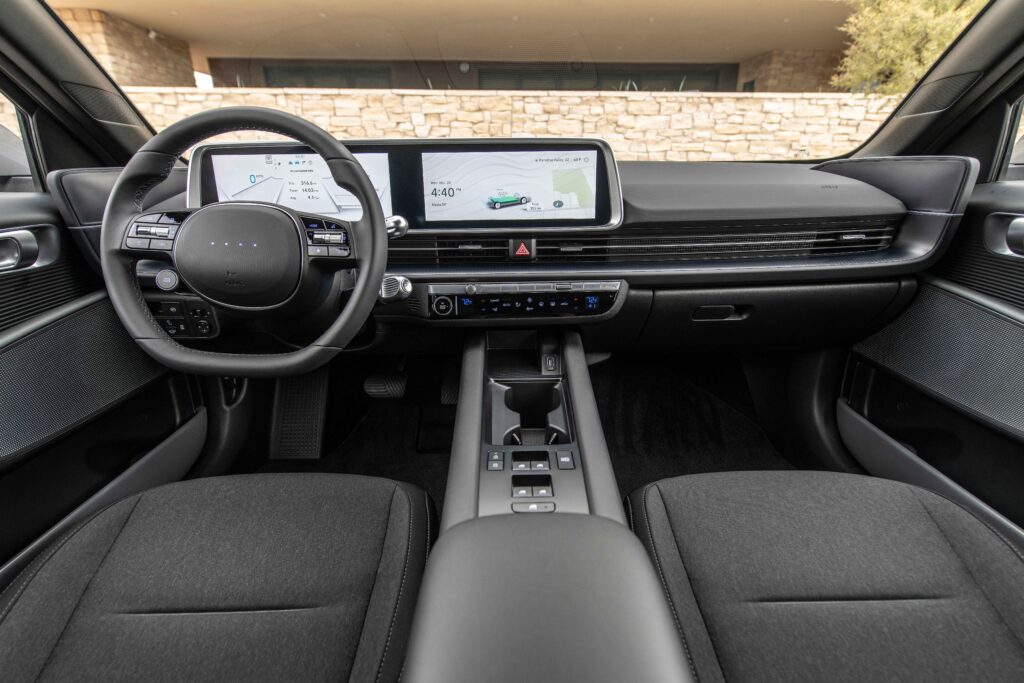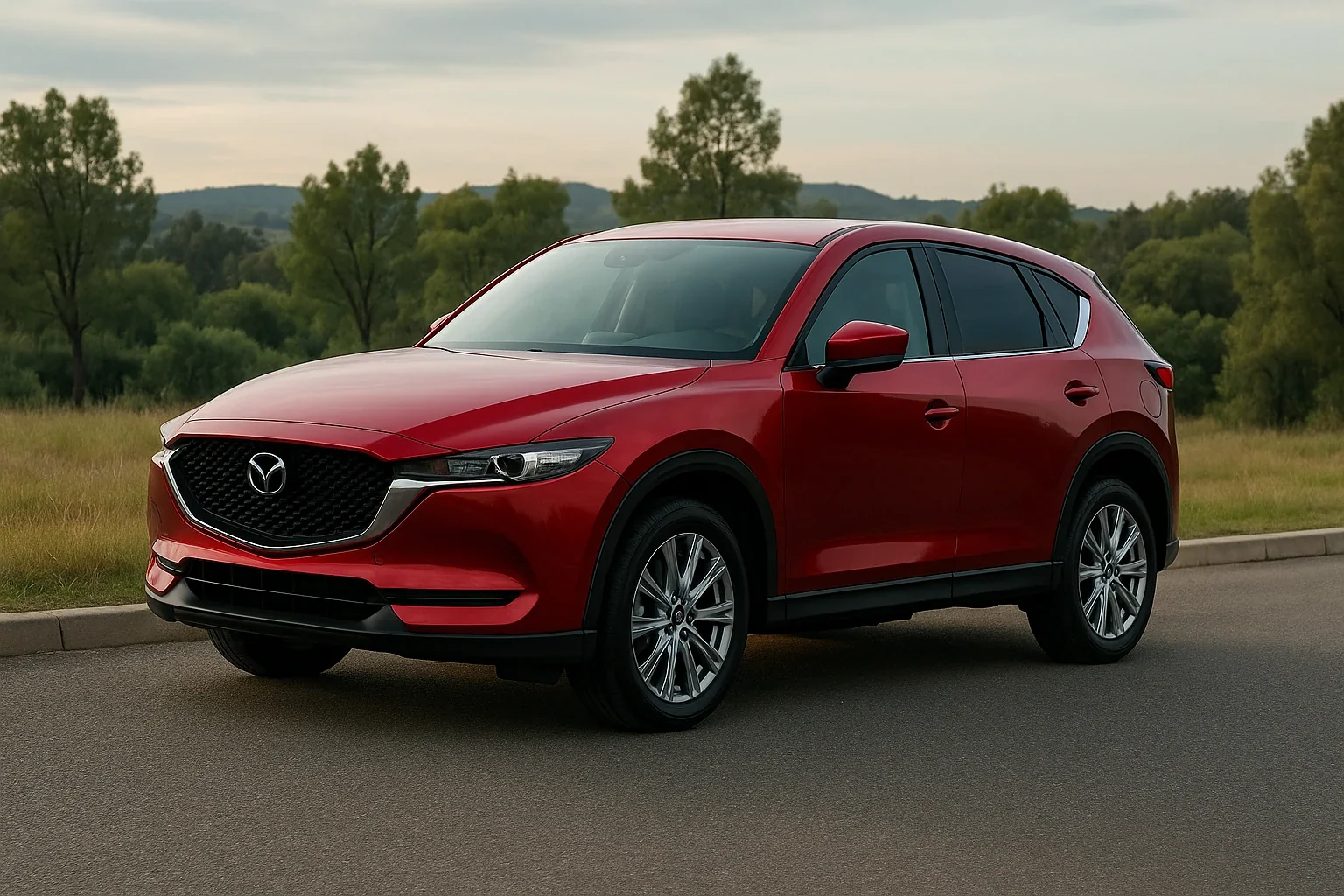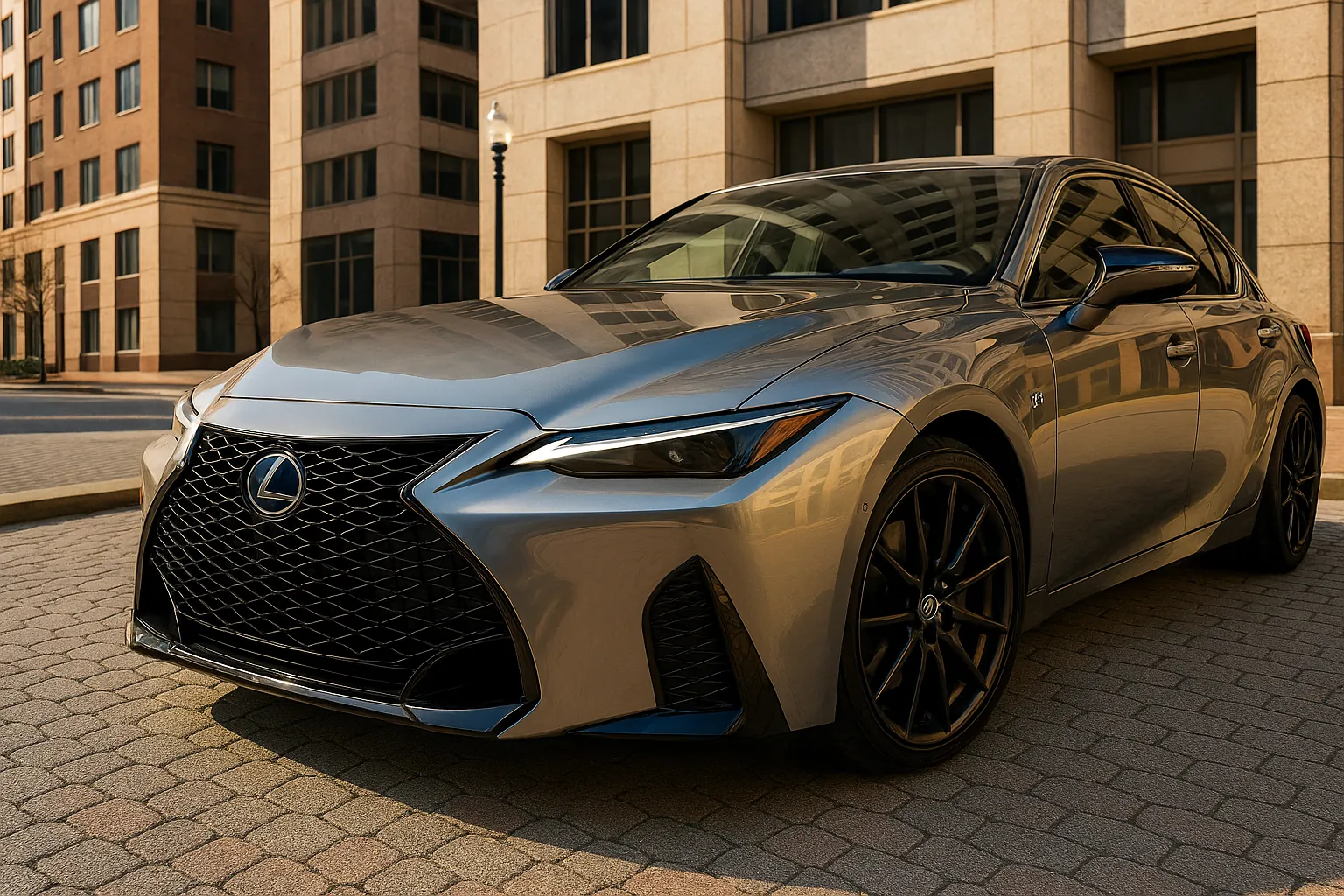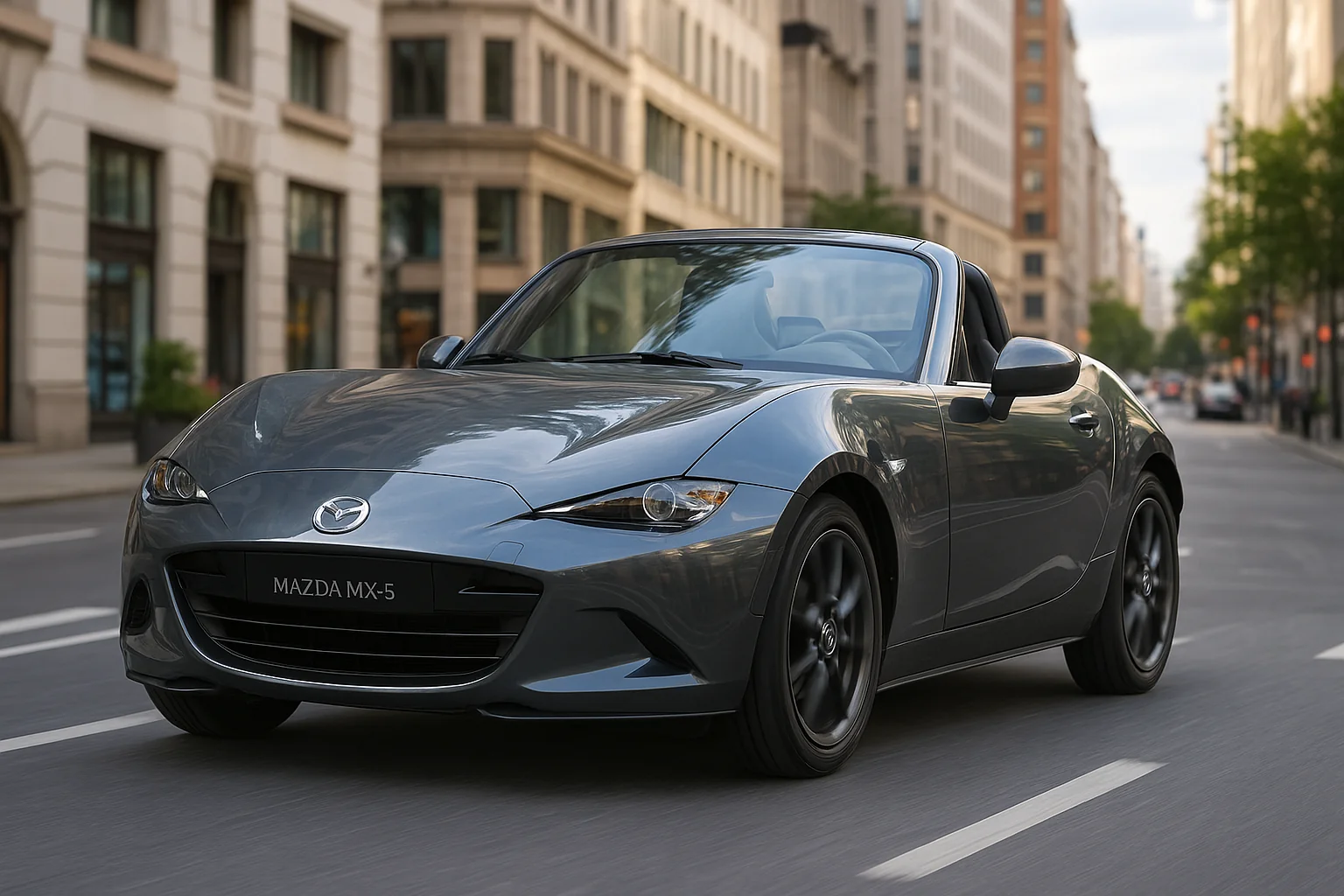
Price: $38,600–$51,300
8.5 /10
Rating
Pros
- Exceptional driving range efficiency
- Rapid fast-charging capabilities
- Competitive pricing versus rivals
Cons
- Cramped rear passenger space
- Occasional tech system glitches
- Limited cargo storage capacity
Overview
The 2024 Hyundai Ioniq 6 isn’t just another electric sedan—it’s a turning point for the Korean brand, blending sharp design with mainstream appeal. Sliding into the driver’s seat, I immediately noticed how its aerodynamic shape (think sleeker sci-fi cousin of the Ioniq 5) cuts through the air like a hot knife, helping it hit an EPA-estimated 361 miles on a single charge. Models like the Hyundai Kona show how the brand balances both electric and traditional options.
During testing, even with the all-wheel drive model, it delivered real-world results close to Hyundai’s promises, though the center screen occasionally threw a tantrum mid-drive—nothing a future fix won’t handle. Priced as a Tesla Model 3 rival, it undercuts its EV competitor while offering a spacious interior and fast charging that’ll juice from 10-80% in 18 minutes.
Sure, practical crossovers and SUVs dominate the industry, but the Ioniq 6’s eye-catching looks and attractive price point make it a top performer for those craving sedans with cutting-edge technology. Hyundai’s come a long way in the past decade, and with this Korean automaker landing on the 2024 Editors’ Choice list, it’s clear they’re betting big on an electric vehicles future.
Just don’t expect perfection—the occasional quirk (like inoperable climate settings until a reboot) reminds you it’s still a human-made machine. But hey, nobody said battery packs and electricity couldn’t have personality.
What's New in 2024?
Fresh off its 2023 debut, the first generation of Hyundai’s electric darling gets minor revisions for 2024, mostly focusing on availability tweaks rather than dramatic changes. During a week behind the wheel, I barely noticed differences from last year’s model year—same standard feature list, same spaceship vibes. The big news? Hyundai introduced a new matte paint option (because everyone needs to feel like a stealthy EV ninja). Honestly, if you’re upgrading from the Ioniq 6’s launch spec, don’t hold your breath—this isn’t a revolution. Think of it as the car equivalent of your phone’s annual “security update.” Still, for newcomers, the 2024 tweaks ensure you’re getting the most polished version of Hyundai’s electric gamble.
Pricing, Trim Levels, and Best Choice
Starting at $38,650 for the base rear-wheel-drive Standard Range, the lineup climbs to $51,300 for the loaded Limited trim with dual-motor all-wheel-drive. My pick? The SE Long Range—it’s the best value, pairing a single-motor setup with a bigger battery pack for that longest range (over 360 miles) without luxury fluff. During a weekend test, the horsepower bump in the dual-motor configuration felt thrilling, but honestly, most folks won’t need it unless they’re chasing stoplight bragging rights. Hyundai’s optional tech packages can bloat the price, so stick to the SEL if you want heated seats without the Limited’s champagne budget. Pro tip: skip the Standard Range battery pack unless your daily drive is shorter than a TikTok scroll.
EV Motor, Powertrain, and Driving Dynamics
Slip behind the wheel, and the Ioniq 6’s powertrain instantly whispers (or roars, depending on your selected mode). The base single-motor RWD model serves up 149 horsepower—adequate for grocery runs but yawn-inducing. Opt for the dual-motor AWD Long Range, though, and its 320-hp punch sprinted to 60 mph in 4.3 seconds during my tested highway merge, leaving SUVs gulping dust.
Hyundai’s platform, shared with the Ioniq 5, gifts it a low center of gravity that makes slicing through corners feel like butter on a hot knife. Regenerative braking via steering-wheel paddles lets you tweak deceleration on the fly, though the smooth ride stays well-isolated even over potholes.
Sure, the 225-hp rear electric motor in mid-tier trims splits the difference, but the AWD’s planted feel and quicker reflexes make it worth the splurge. Just don’t expect Porsche drama—this is engaging comfort, not a track star. And hey, thanks to that bigger battery, you’ll grin longer between charges.
Range, Charging, and Battery Life
Gliding onto the highway in the Long Range RWD model, I completed a real-world test achieving 270 miles at 75-mph—close to its EPA estimate of 361 miles, though the AWD version dipped to 260 miles. Hyundai’s shortest-range SE trim offers just 220 miles, but spring for the Ioniq 6’s bigger battery and you’ll net a 58-mile advantage over the Ioniq 5.
During a weekend road trip, the 2024 Long Range still delivered an impressive highway range (around 100 miles more than the Limited’s estimated city-focused ratings), though cold weather could change that math. Pro tip: If maximum driving range is your jam, skip the all-wheel-drive hype—stick to rear wheels and relish those extra miles.
Fuel Economy and Real-World MPGe
Numbers nerds, rejoice! The rear-drive Long Range Ioniq 6 nails an EPA combined rating of 140 MPGe—enough to make gas pumps weep. During my week mixing highway sprints and downtown crawls, the SE trim’s fuel economy hovered near Hyundai’s estimated numbers, though cold mornings shaved 10% off. Pro tip: Your mileage may vary (check the EPA’s website for nitty-gritty details), but this EV still sips electrons like a barista savors espresso.
Interior and Comfort
Step inside, and the cabin greets you with a serene, quiet vibe—until you spot the touchscreen’s buttons buried like hidden treasure. Front seats offer lumbar support and ventilated seats (blessed cool during summer road trips), though the rear bench suffers from small rear windows and thick roof pillars that turn rear visibility into a guessing game. At highway speeds, wind noise stays hushed, but the sloping roofline steals rear headroom—6-foot passengers will feel like they’re dodging a low bridge. The center console’s placement of physical buttons (hello, heated seats!) is a win, though door openings feel tall for shorter folks. The floaty suspension on rough pavement left my coffee cup dancing, and the high floor eats into knee room for adults in the back seat. Still, ride quality leans comfortable, and those ventilated front seats? Worth their weight in gold when temps spike.

Cargo & Practicality
Pop the trunk, and you’ll find 11.2 cubic feet of space—same amount as a Tesla Model 3 but tighter than a Honda Civic’s 19.8 cubes. During my luggage test, a large suitcase and small bag fit snugly, though the deep floor made access feel like spelunking. Underfloor storage hides charging cables, while small nooks near the wireless charging pad swallow a purse or sunglasses. The rear LATCH anchors simplify installing car seats, but rear legroom’s a squeeze for adults. Front doors pack wide storage bins, and the front seats’ storage bin fits smaller items… unless you’re hauling a Yeti cooler. Compared to the Civic, it’s tough to argue Hyundai’s spec sheet wins, but for daily maneuvers, it’s enough—just don’t quit your Tetris hobby.
Tech & Connectivity
Sliding into the cabin, the center system greets you with a user experience that’s mostly intuitive—until you dive into the menu structure, which feels like solving a Rubik’s Cube blindfolded. Wireless Apple CarPlay and Android Auto integrate seamlessly, though the lone USB-A port (alongside two USB-C ports) had me digging for ancient cables. The Highway Driving Assist 2 shines, accelerating smoothly, slowing down for traffic, and executing lane changes with the confidence of a overcaffeinated valet. Plugging a route into Google Maps triggers battery preconditioning for faster charging, a genius trick if you remember to stop inputting destinations mid-drive. My gripe? The third-party app support is thinner than a rice cracker, and finding the closest charging station via the list format requires more taps than a Morse code session. Still, for smartphone connectivity and automatic updates, it’s a fast leap beyond Hyundai’s trim levels of the past—just don’t expect Tesla-level polish.
Safety
Hitting the highway, the lane-keeping assist and adaptive cruise control felt like a nervous co-pilot—alarmingly attentive but occasionally overzealous. The Ioniq 6 aced IIHS crash-test results, earning a Top Safety Pick+ nod, while the NHTSA gave it five stars. Blind spot monitoring and pedestrian detection worked flawlessly during my downtown crawl, though the camera-based exterior mirrors (a Korean-market gem) remain MIA stateside. The pre-collision safety system once slammed brakes for a rogue shopping cart—better safe than sorry, right?
Key features:
✅ Top Safety Pick+ rating from IIHS reinforces crashworthiness.
✅ Overcautious lane-centering features may annoy confident drivers.
✅ Post-collision system automatically alerts emergency services if deployed.
Warranty and Maintenance Plan
Hyundai’s 10-year/100,000-mile battery warranty is the automotive equivalent of a security blanket—industry-leading and borderline obsessive. The limited warranty covers five years/60,000 miles, while the powertrain warranty stretches to 10 years/100,000 miles, outlasting most rivals. But here’s the rub: scheduled maintenance is only covered for three years/36,000 miles, so your wallet’s on the hook after that. During my ownership stint, the impressive coverage eased range anxiety, though I’d trade a year of warranty plans for free tire rotations.
Key features:
✅ Decade-long battery warranty dwarfs most competitors’ offers.
✅ Basic maintenance plan expires sooner than luxury brands’.
✅ Powertrain coverage ensures long-term peace of mind.
Gallery:
Images sourced from Hyundai Newsroom.






This Post Has 3 Comments
Pingback: 2023 Volvo XC40 Recharge Review: Power, Range & Worth It?
Pingback: 2023 Volvo V60 Review: beautiful but bruised
Pingback: 2025 Honda Civic Hybrid Review: Efficiency That Excites